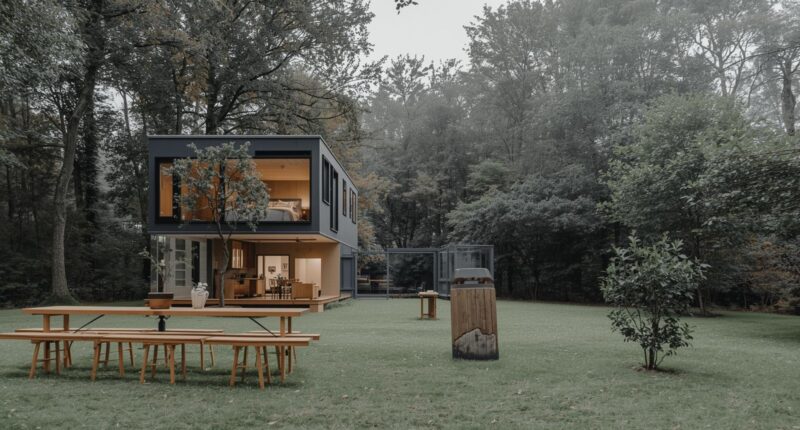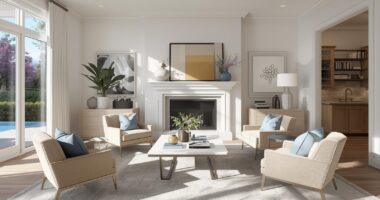Minimalist Living: Small Homes and Apartments with Big Impact
The Beauty of Minimalist Living
In a world filled with consumerism and clutter, more people are embracing minimalist living as a path to simplicity, efficiency, and freedom.
Small homes and apartments are no longer seen as limitations — they’re becoming symbols of smart living and sustainable design.
With rising housing costs and the demand for eco-friendly lifestyles, minimalist small homes are reshaping how we think about comfort, design, and personal space. By choosing to live with less, you gain more financial freedom, flexibility, and peace of mind.
The Philosophy Behind Minimalist Living
Minimalist living is about focusing on what truly adds value to your life — and removing what doesn’t.
It’s not about giving up luxury, but about redefining it.
In minimalist homes, every design choice serves a purpose — creating open, functional spaces that promote calm and creativity.
Core Principles of Minimalist Home Design
-
Simplicity: Clean lines and uncluttered spaces.
-
Functionality: Every item has a clear purpose.
-
Natural light: Enhances mood and perception of space.
-
Quality over quantity: Invest in durable, timeless materials.
-
Mindful consumption: Buy less, live more.
A minimalist lifestyle empowers you to live intentionally, freeing your time and finances for what matters most.
Table – Small Home vs. Large Home Lifestyle Impact
| Aspect | Small Home / Apartment | Large Home |
|---|---|---|
| Maintenance Cost | Low – fewer utilities and cleaning | High – increased upkeep expenses |
| Energy Efficiency | More eco-friendly | Consumes more resources |
| Design Flexibility | Encourages creativity | Often over-decorated |
| Financial Stress | Lower mortgage or rent | Higher debt and costs |
| Lifestyle Focus | Simplicity and purpose | Accumulation and storage needs |
This comparison shows how small-space living can bring big financial and emotional benefits — while aligning with modern sustainable values.
Smart Design Choices for Small Homes
To make small spaces feel spacious and functional, smart interior design is key.
By optimizing layout, lighting, and multifunctional furniture, you can transform even the tiniest apartment into a cozy, stylish retreat.
Design Tips for Maximum Impact
-
Use neutral color palettes to create a sense of openness.
-
Incorporate multi-purpose furniture like foldable tables or sofa beds.
-
Utilize vertical storage — wall-mounted shelves and hanging plants.
-
Maximize natural light with large windows or mirrors.
-
Keep décor minimal yet elegant.
Link: For more inspiration, check out our guide — Lifestyle-Driven Home Design Trends for 2025 — to explore how modern home design adapts to evolving lifestyles.
Financial Freedom Through Small-Scale Living
Downsizing to a smaller home can have a massive financial impact.
Fewer rooms mean lower rent or mortgage payments, cheaper utilities, and less furniture to buy.
The money saved can go toward investments, travel, or personal growth — creating true financial freedom.
Key Financial Benefits
-
Reduced housing costs: Save on rent or property tax.
-
Lower utility bills: Heating, cooling, and lighting smaller spaces cost less.
-
Less clutter, fewer expenses: Minimalism discourages unnecessary spending.
-
Increased savings potential: Extra money can go into investments or side businesses.
Living small doesn’t mean living less — it means living smarter.
Sustainability and Eco-Friendly Living
Minimalist small homes align perfectly with sustainability goals.
Smaller spaces naturally use fewer resources, producing less waste and carbon emissions.
Eco-Friendly Features to Include
-
Solar panels and energy-efficient appliances.
-
Recycled or reclaimed materials for furniture.
-
Water-saving fixtures and smart thermostats.
-
Indoor plants to improve air quality.
Link: Learn more about sustainable housing at Green Building Advisor, where you’ll find eco-conscious design tips for small, energy-efficient homes.
These choices not only protect the planet but also reduce long-term living costs.
Emotional and Mental Health Benefits
Beyond financial and environmental advantages, minimalist living enhances mental well-being.
A decluttered environment encourages focus, relaxation, and mindfulness.
Psychological Benefits
-
Less clutter = less stress.
-
Simplified design promotes mental clarity.
-
Owning fewer possessions encourages gratitude.
-
Space efficiency reduces overwhelm and anxiety.
When your surroundings are peaceful, your mind follows — turning your home into a place of serenity and balance.
The Rise of Micro Apartments and Tiny Homes
Cities around the world are embracing micro-apartments and tiny homes as modern living solutions.
They combine practicality, affordability, and sustainability while maintaining comfort and style.
Why Tiny Living Works in 2025
-
Ideal for urban professionals seeking financial independence.
-
Promotes community-focused developments.
-
Integrates smart home technology for convenience.
-
Offers flexibility for frequent travelers and digital nomads.
This trend proves that smaller living spaces can create bigger opportunities for happiness and personal growth.
How to Start Your Minimalist Living Journey
Transitioning to a minimalist home begins with intention and planning.
You don’t need to downsize overnight — start by simplifying your environment step by step.
Practical Steps to Begin
-
Declutter one room at a time — keep only what adds value.
-
Donate or sell unused items.
-
Redesign your home for openness and flow.
-
Focus on quality essentials that serve multiple purposes.
-
Build habits of mindful consumption and simple living.
Minimalism is not a destination; it’s a lifelong process toward freedom and clarity.
Conclusion: Small Space, Big Freedom
The future of living is not about size — it’s about intentional design and conscious choices.
Minimalist small homes and apartments embody freedom, sustainability, and smart financial management.
By simplifying your surroundings, you make space for what truly matters — peace, growth, and fulfillment.
Living small can have a big impact on your wallet, your well-being, and the world around you.
Minimalism isn’t about less — it’s about living better with less.









